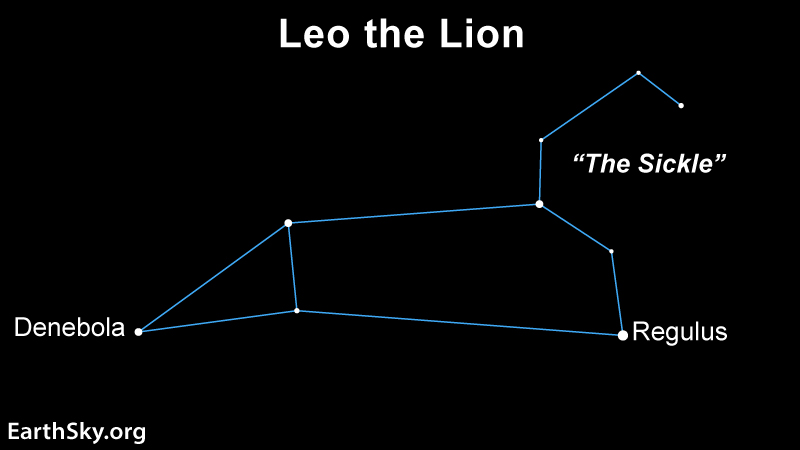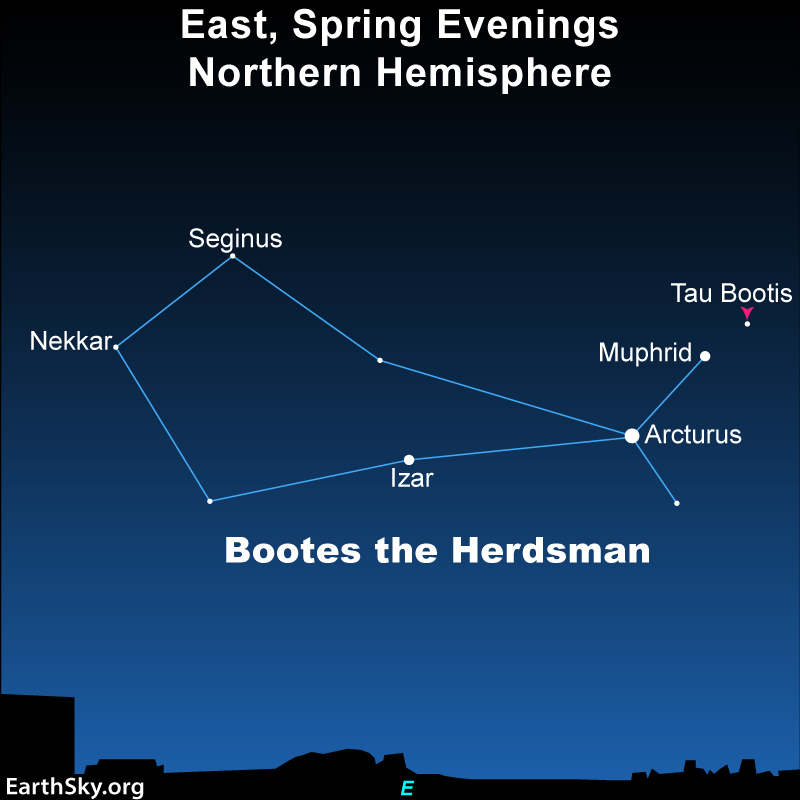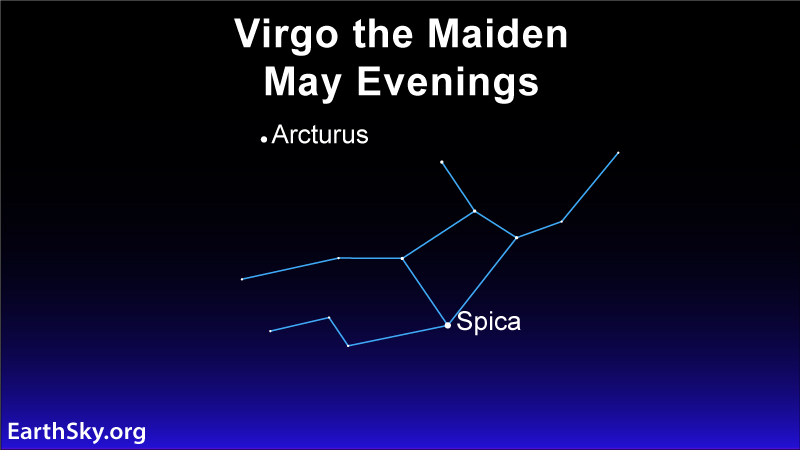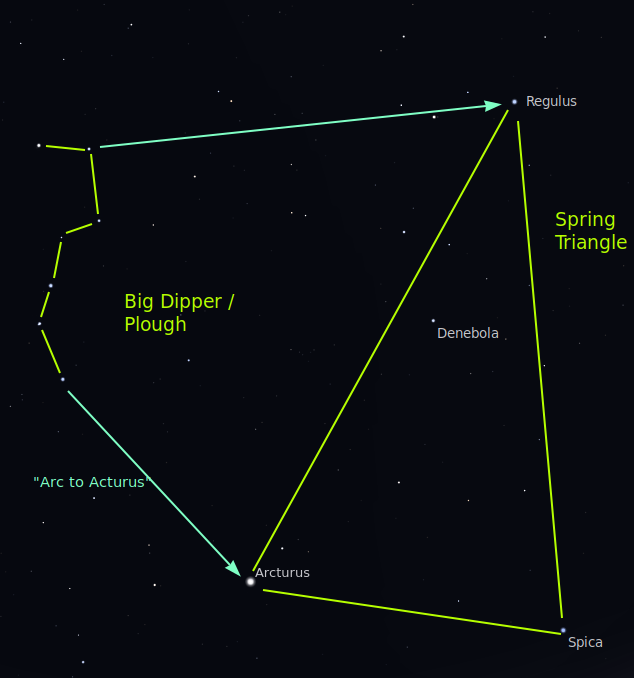
The Spring Triangle heralds warmer weather
Around the time of the March equinox, a trio of wide-spread stars rises in the east after dark. The Spring Triangle announces the slide into shorter nights and warmer weather for the Northern Hemisphere. Regulus in Leo the Lion is the first to rise above the horizon, having risen before the sun has even set. It’s followed by Arcturus in Boötes the Herdsman. And, just a bit later, Spica in Virgo the Maiden joins the group. These three bright stars create a narrow pyramid stretching up from the horizon.
Join us in making sure everyone has access to the wonders of astronomy. Donate now!
The Spring Triangle is entirely above the horizon before midnight in March. And by early April, its three stars are visible by mid-evening (midway between sundown and midnight).
Once you come to know it, when you see the Spring Triangle stars above the houses across the street, you can almost feel the warm springtime air.
The Spring Triangle is an asterism
Like the sky’s other seasonal shapes (for instance, the Summer Triangle and Winter Circle or Hexagon), the Spring Triangle isn’t a constellation. It’s not one of the 88 regions of the sky officially recognized as constellations by the International Astronomical Union.
Instead, it’s an asterism, an unofficial but recognizable pattern of stars that can be in one constellation or in multiple constellations. Asterisms are what many of us would pick out as constellations, if we didn’t know any constellations. That’s because they’re often the sky’s most recognizable patterns.
Let’s look at how to find these stars so we can watch them move across the night sky.

Regulus
As soon as it’s dark around the March equinox, look for a bright yellowish star twinkling above the eastern horizon. That’s Regulus, and it’s easy to confirm if you’ve spotted the right star. If the star you’re targeting marks the period in a backward question mark pattern of stars, you’ve got it. This question mark shape is another asterism known as the Sickle in Leo. The curve of the question mark traces the head of the lion and Regulus is the Lion’s heart.
When we look at Regulus, we only see one star, but it’s actually a four-star system. From about 79 light-years away, the light from the four stars makes one point of light in the night sky. The brightest star in this system is a yellow supergiant about three times the size of our sun.

Arcturus
Next up is Arcturus, the brightest star of the three in the Spring Triangle. For those at northerly latitudes, Arcturus is the second-brightest star visible on the sky’s dome, after Sirius, which is currently in the southwestern sky. (Those at more southerly latitudes, like the southern U.S., can see the sky’s actual second-brightest star, Canopus, in the south.) Arcturus is a gorgeous old red giant about 37 light-years away. Billions of years in the future, when the sun has burnt up its own hydrogen fuel supply, it will turn into a star like the type Arcturus is now.

Spica
If Arcturus has risen, Spica is not far behind. Look for Spica lower in the sky than Arcturus – and father toward the south, or right – of the others. From a distance of 250 light-years away, Spica appears to us on Earth to be a lone bluish-white star in a quiet region of the sky. But Spica consists of two stars and maybe more. The pair are both larger and hotter than our sun, and they’re separated by only 11 million miles (less than 18 million km). They orbit their common center of gravity in only four days.
A triangle inside the triangle
If you can spot the Spring Triangle, you may notice there’s a second triangle inside the larger triangle. The smaller triangle excludes Regulus but includes yellowish Denebola, a double star about 36 light-years away that marks the Lion’s tail. Denebola is the second brightest in Leo. To see this second triangle, see the chart below.

The Spring Triangle is less attention-grabbing than the Winter Circle (or Hexagon) and the Summer Triangle. If you’re having trouble finding it, there’s another way. Use the Big Dipper for extra help.
Finding the Spring Triangle

Toward the north, look for the Big Dipper, called the Plough in the United Kingdom. This time of year, by mid-evening it’s ascending in the northeast. If you draw a line from the two stars at the end of the Dipper’s bowl or blade – Dubhe and Merak – and extend it toward the south, you’ll reach Regulus.
Then, follow the curve of the Dipper’s handle away from the bowl to arc to Arcturus and continue the line downward to speed on down to Spica.
Surprisingly enough, the Spring Triangle is bigger than its more famous summertime cousin, and it’s almost as big across as the Winter Hexagon. Yet it’s not one of the best-known star patterns.
Once you’ve found the Spring Triangle, you’ll enjoy it year after year. Maybe because it appears as spring arrives, this pattern seems full of optimism for good things to come!
Bottom Line: Look for a sign of the changing seasons in the heavens as the Spring Triangle, made up of the stars Regulus, Arcturus and Spica, rises above the horizon in the east over the next couple of months.
The post Spring Triangle in the east at night, heralding the season first appeared on EarthSky.